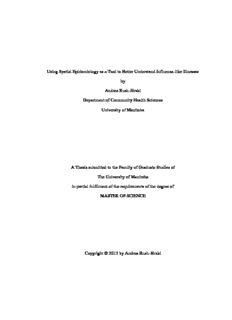Table Of ContentUsingSpatialEpidemiologyas aTooltoBetterUnderstand Influenza-likeIllnesses
by
AndreaRush-Sirski
DepartmentofCommunityHealthSciences
UniversityofManitoba
AThesissubmittedtotheFacultyofGraduateStudiesof
TheUniversityofManitoba
inpartialfulfilmentoftherequirementsofthedegreeof
MASTER OFSCIENCE
Copyright©2013byAndreaRush-Sirski
Abstract
InfluenzaisapopulationhealthissueinCanada,withanannualinfectionrateof
10-25%ofthepopulation. Thepurposeofthisthesis wastoanalyzeinfluenza-like
illnesses(ILI)forthefiscalyears(April1toMarch31)from 2004-05throughto2008-
09,bothspatiallyandtemporally,throughouttheprovinceofManitoba. ILI, forthe
purposeofthis study,includeddiagnosesofpneumoniaandinfluenzaand acute
respiratoryinfectionasdeterminedbyICD-09 andICA-10codes. As withother
publishedstudiesandtheaccepteddefinitionsof ILI, repeatcaseswithinaseasonwere
included.Theanalysisusedaframeworkspecifictospatialanalysis,andincorporatedthe
principlesofpopulationhealthandecologicalframeworks. Theunderlyingobjectivesof
theresearchweretobetterunderstandthepatterns of ILIdiagnoses aswell as the
characteristicsofthosediagnosed.
Thedatawereexploredinthreeways: employingmethodsofdatavisualisation,
explorationandmodeling,withtheincorporation ofthedeterminants ofhealthtoinform
theresultsand guidethechoiceofregressionvariables. Differentmapswerecreatedto
showtheresultsfromvarious perspectivesandnegativebinomialregressionanalysis was
usedtotestwhich,ifany,ofthechosenvariables (includinghouseholddensity, co-
morbidityscore,incomequintileandage)weresignificant.
Basedonthisresearch,onecouldconcludethatalthoughclustersofILIdo exist
intheprovinceofManitoba,aclearrelationshipdoesnotexistbetweenthedeterminants
ofhealthand ILIas was expected. Althoughthe agevariable yieldedpredictableresults,
higher riskofdiagnoses amongstthehighdensityhouseholds orinthelowestincome
ii
quintileswasnotobserved. Itishoweverunclear as tohowtheseresultswereaffectedby
thelimitationsofthestudy, particularlytheinclusionofrepeatcases.
iii
Acknowledgements
Although Iamtheauthorofthisthesis,Ifeelconfidentsayingitwas agroup
effort. Thereweresomanypeoplewhoofferedtheirsupportinvariousways and Ican
honestlysaythateveryoneinmylifewhilecompletingthisadventuredeserves
recognition. Ithank you all.
Inparticular, Iwouldliketoacknowledge thefinancialsupport Iwas fortunateto
receivefromtheCanadianInstitutes ofHealthResearch andthe WesternRegional
TrainingCentre. Theirsupportwasnotonlymonetarybutalsoeducational,providing
mewiththeopportunitytotraveltovariousconferences and gainexposuretoother
researchers. This travel wasfurtherfacilitatedbythevarioustravelawardsIobtained
whichalsocontributedto mylearningexperience.
IwouldliketoacknowledgetheManitobaCentreforHealthPolicyforuseofdata
containedinthePopulationHealthResearchDataRepositoryunderproject #2010/2011-
06. Theresultsandconclusionsaremyownand noofficialendorsementbythe
ManitobaCentrefor HealthPolicy, ManitobaHealth,orotherdataprovidersisintended
orshouldbeinferred.
Iwouldalsoliketo acknowledgemythesiscommitteeandofferallof you a
heartfeltthank you. Eachofyouprovided mewithaverydistinctareaofexpertisethat
trulyhelpedshapemythesis. Icannotimaginehavingcompletedthisventurewithout
anyof you. Iamso gratefulto you-Alan,CarolandChris–fortheconstructive
feedbackand guidancethatyouprovidedalongtheway.
Mycommitteewasledbymyadvisor,Michelle;thisis as much your
accomplishmentasitismine. Yourencouragementandsupportwereparamountinthe
iv
completionofmydegree. Thanksto you Iwas givenopportunities totravelandtakepart
inconferencesthatIwouldhaveotherwisenothad. Youmadeagreatdifferenceinmy
developmentintheareaofCommunityHealthSciences thatwillreflecton myfuture
projectsthroughoutmycareer.
TheDepartmentofCommunityHealth Sciencesislikenoother. Iamso grateful
tomyfellowstudentsfor theirongoingsupportandmotivation. Wehavehelpedeach
otherthroughmanymomentsoffrustrationandtheoccasionaldesireto giveup.
Friendshipsandbondshavebeenformedoverweekends andeveningsofintensestudying
inordertomakeadeadline. Ilookforwardtocontinuingtointeractwithallofyouon a
professionalandpersonalbasis. Tothefaculty,Ialsosaythank you. Ireallyhave
enjoyedmytimeas aCHSstudentandwouldrecommendourprogramtoeveryone.
Though Isometimesdoubtedthatthisthesiswouldeverbefinished,myfamily
andfriendsneverdid. Whenfrustrationwouldsinkinafteralongday, you werealways
theretolistenandencouragemeto keep going;when Ineededbabysitterstofinishthe
lastdetails,youwerethere–thank you. Ilove youall. Ishareallofmy
accomplishmentswithmyhusband Danielanddaughter Emilia– youweremy
inspirationandmotivation.
v
TableofContents
Abstract................................................................................................................................ii
Acknowledgements.............................................................................................................iv
TableofContents................................................................................................................vi
ListofTables...............................................................................................................viii
Listof Figures.................................................................................................................ix
ListofCopyrighted
Figures............................................................................................xi
ListofAppendices..........................................................................................................xi
Chapter1-Introduction.......................................................................................................1
Purpose.............................................................................................................................2
StudyObjectives and Hypotheses....................................................................................2
ChapterSynopsis..............................................................................................................4
Chapter1– Introduction...............................................................................................4
Chapter2–TheoreticalFrameworks...........................................................................4
Chapter3–Background and LiteratureReview..........................................................5
Chapter4– Methodsand Analysis...............................................................................5
Chapter5–Results.......................................................................................................6
Chapter6–Discussion.................................................................................................7
Chapter7–Conclusion................................................................................................7
Chapter2–TheoreticalFrameworks...................................................................................9
PopulationHealth Framework.........................................................................................9
Thedeterminantsofhealth.........................................................................................11
Ecological Framework...................................................................................................16
Spatial Framework.........................................................................................................18
Chapter3-Background and LiteratureReview................................................................19
Influenzaand Influenza-likeIllnesses............................................................................20
PandemicInfluenza........................................................................................................26
EpidemiologyofInfluenzainManitoba........................................................................27
Place,SpaceandTime...................................................................................................34
SpatialEpidemiology:DataVisualisation,DataExploration,DataModeling..............36
vi
Datavisualisation.......................................................................................................36
Dataexploration.........................................................................................................37
Datamodeling.............................................................................................................38
Chapter4-Methodsand Analysis.....................................................................................41
StudyAreaand StudyPeriod.........................................................................................41
DataSources...................................................................................................................44
StudyPopulation- InclusionCriteria.............................................................................46
StudyPopulation-ExclusionCriteria............................................................................51
Analysis..........................................................................................................................51
PreparationoftheData...................................................................................................52
Objective1–DataVisualisation....................................................................................54
Temporaldistribution.................................................................................................54
Spatialdistribution......................................................................................................55
Objective2–DataExploration......................................................................................57
Objective3–DataModeling.........................................................................................57
StudyVariables...........................................................................................................58
Chapter5-Results.............................................................................................................62
Objective1–DataVisualisation....................................................................................63
Objective2–DataExploration......................................................................................75
Objective3–DataModeling.........................................................................................78
Chapter6-Discussion.......................................................................................................86
Objective1–DataVisualisation....................................................................................87
Objective2–DataExploration......................................................................................90
Objective3–DataModeling.........................................................................................91
StudyLimitations andAssumptions..............................................................................98
Chapter7-Conclusions...................................................................................................102
Bibliography....................................................................................................................107
Appendices.......................................................................................................................116
vii
ListofTables
Table1–CDC WeekofFirstand Last LaboratoryConfirmedCasesbyStudyYear.....29
Table2-Datasetstobeused............................................................................................45
Table3- ICD-09-CMCodestobeincludedin ILIdefinition......................................47
Table4- ICD-10-CA Codestobeincludedin ILIdefinition.......................................48
Table5–PercentofStudyPopulationbySpecificICDCode.........................................49
Table6–CDCweeksusedfromeach FiscalYearofAdministrativeData.....................50
Table7– ICD–10–CACodesShowingICD–9 –CMCodeEquivalent....................53
Table8- Studyvariables includedinanalysis..................................................................60
Table9- InitialCaseDataforTotal Population...............................................................62
Table10–CaseDatafor StudyPopulationDuringInfluenzaSeason2004/2005–
2008/2009(CDC weeks 39-17)........................................................................................63
Table11–SimpleNegativeBinomialRegression Results..............................................80
Table12-MultipleNegativeBinomialRegression Results............................................82
viii
ListofFigures
Figure1- Apopulationhealthframework.......................................................................10
Figure2- Thedeterminants ofhealth...............................................................................12
Figure3- Populationhealthpyramid...............................................................................13
Figure4– Manitoba PrematureMortalityRates byHealthDistrictandNeighbourhood
Cluster...............................................................................................................................16
Figure5- Laboratoryconfirmedinfluenzacases byCDCweekbyseason.....................30
Figure6- Agedistributionoflaboratoryconfirmedinfluenzacases byseason..............31
Figure7- Agedistributionoflaboratoryconfirmedinfluenzacases for2008/2009season
...........................................................................................................................................31
Figure8- Laboratoryconfirmedinfluenzacases byregionalhealthauthoritybyseason32
Figure9- Laboratoryconfirmedinfluenzacases byseasonandserotype.......................33
Figure10- ManitobaRegionalHealthAuthorities andHealthDistricts.........................42
Figure11- WRHANeighbourhoodClusters...................................................................43
Figure12- TotalNumberof ILIin ManitobaperCDC Weekfrom2004/2005to
2008/2009.........................................................................................................................50
Figure13- TemporalandSpatialVariationofCombinedYears fortheEarlySeason...66
Figure14- TemporalandSpatialVariationofCombinedYears fortheEarly-MidSeason
...........................................................................................................................................67
Figure15- TemporalandSpatialVariationofCombinedYears fortheMidSeason.....68
Figure16- TemporalandSpatialVariationofCombinedYears fortheLateSeason.....69
Figure17- TemporalandSpatialVariationofCombinedYears oftheHealthDistricts 71
Figure18- TemporalandSpatialVariationofCombinedYears oftheNeighbourhood
Clusters.............................................................................................................................72
Figure19-CumulativeILIRates forCombinedYearsbyHealthDistrict......................73
Figure20-CumulativeILIRates forCombinedYearsbyNeighbourhood Cluster........74
Figure21- SpatialVariationofCombinedYearsfortheILISeason..............................75
Figure22- Areas ofHighand Low LikelihoodtoClusterAccordingtoSpatialScan
Statistic..............................................................................................................................77
ix
ListofCopyrightedFigures
Figure1- Apopulationhealthframework........................Error!Bookmarknotdefined.
Evans,R.,& Stoddart,G.(1990).Producinghealth,consuminghealthcare. Social
Scienceand Medicine,1347-1363.
Figure3- Populationhealthpyramid................................Error!Bookmarknotdefined.
Etches,V., Frank,J.,Di Ruggiero,E., &Manuel, D.(2006). MeasuringPopulation
Health:AReviewofIndicators.AnnualReview ofPublicHealth,27:29-55.
x
Description:published studies and the accepted definitions of ILI, repeat cases within a season and modeling, with the incorporation of the determinants of health to inform contained in the Population Health Research Data Repository under project Variations in influenza vaccine programs exist across the.

